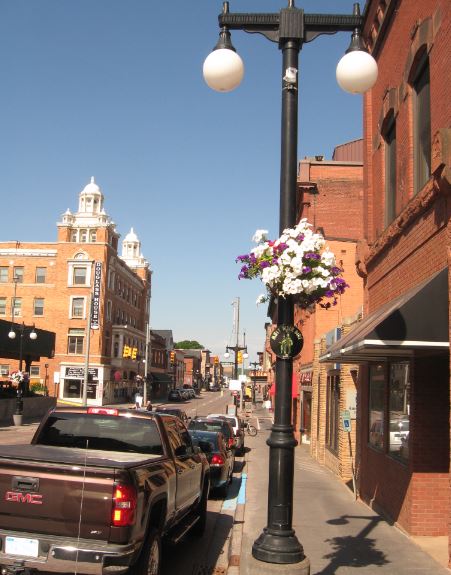A Trip to Houghton, Michigan
Think Hoe Ton. We originally wanted to park our rig there, but all suitable RV sites were booked full, so we stopped 25 miles to the south in Baraga. We checked out the City RV Park on our first ride up to Houghton and saw that it was a bit tight and believe we would not have fit so well, especially with every site being occupied. So it all worked out well. We didn't know much more about Houghton, but learned plenty on our short excursion. As soon as we arrived at the city limits we were met by a sign that said this place was the birthplace of Professional Hockey... What?!?!Pepé with kayaks on top in the background.
We headed downtown to see what Houghton was all about. We stopped first at the Chamber of Commerce for more info. They let us park in their lot, so we took a walk around the quaint town.
A few shots from around downtown.
A small park area in the center of town.
 Probably designed by these folks right next door.
Probably designed by these folks right next door.Another park area separated by an artistic bicycle fence and carrying a powerful Jimi Hendrix quote, "When the power of love overcomes the love of power the world will know peace."
We saw our first moose downtown. One was a bull moose, the other is just full of bull!
Later we walked down the hill to the river front to see what was there. The first thing we came upon was the bridge view that leads into Hancock and points north on the Keweenaw Peninsula. We plan to go over that bridge one day. We hear there are Gray Wolves, Black Bear and Moose up there.
Gari at Bridgeview Park.
Steve's turn.
Compliments of the Beautification Committee along the waterfront.
At the end of Water Street we came upon the Amphidrome, also known as Dee Stadium. Right now it is an interpretive museum. We went in and learned the story of how Houghton became the birthplace of Professional Hockey... It is quite a story and we guess it's true!
Gari selects her skating buddy outside the rink in the Amphidrome. A business man named James Dee collaborated with the young Canadian town Dentist, John "Doc" Gibson to get things started. Houghton was a booming (mainly copper) mining town, and those miners craved entertainment. Hockey was just the thing Dee thought! He built the Amphidrome in 1902. Doc knew all the best Canadian hockey players and built the team. The Portage Lakes (Houghton) won the first National Championship in 1903 and the AHA was established (American Hockey Assoc.) In 1904 Portage Lakes won the first World Championship and the IHL (International Hockey League) was formed and this marked the official beginning of Professional Hockey.
In 1927 the Amphidrome was destroyed by a January fire. It was rebuilt on the same site in 1928.
Various hockey artifacts were found in a collection room.
Steve stands by team photos and uniforms from days gone by.
A large plaque the likeness of the Amphidrome hangs above the large dance hall overlooking the rink.
Last stop of the day was at the Mineral Museum on the campus of Michigan Technological University.
We parked by the Copper Pavilion and stopped in there first to see the 71 Ton slab of natural copper.
Steve standing by the enormously heavy slab.
The Civil Engineering student explains to Steve how they made measurements to determine the density of the specimen.
Gari stops to review the magnificent copper crystal in the foyer.
I had no idea that copper would crystallize like that; the facets are spectacular!
Gari stands by the large sheet copper specimen.
The entire museum was packed with a dizzying number of magnificient rocks of all shapes, colors and materials.
The big actor here was certainly the copper.
Rows, upon rows of specimens!
Gari next to another of the large copper specimen.
An interesting Geode from Brazil.
Say hello to the Two Circle Goniometer. This instrument is used to measure the angle between the external faces of crystals in minerals and thus assist in identification of the sample. The geology of the Lake Superior area is fascinating and requires Goniometry! The theory is that a very long time ago magma welled up in the area and penetrated the Earth's crust. This welling up caused cracks and fissures in the Earth's crust. Over time the area cooled and began to sink, which cause more fissures and cracks at different angles. Later the Ice Age came and glaciers advanced and retreated many times leaving deposits carried in from great distances, and aided in local sedimentation to fill in the sunken area. The elements and atoms that were in this area then found their way into solution and traveled into the cracks and fissures of the area. These solutions would even mix with each other and become complex solutions. Overtime the liquid would reduce and cool, and the elements present would begin to crystallize and be left behind. Hopefully now you can see how useful the Goniometer can be when working to identify a crystallized specimen.
Last but not least our favorite display, the Florescents!
Before in natural light...
Last...Before
and After!



































No comments:
Post a Comment